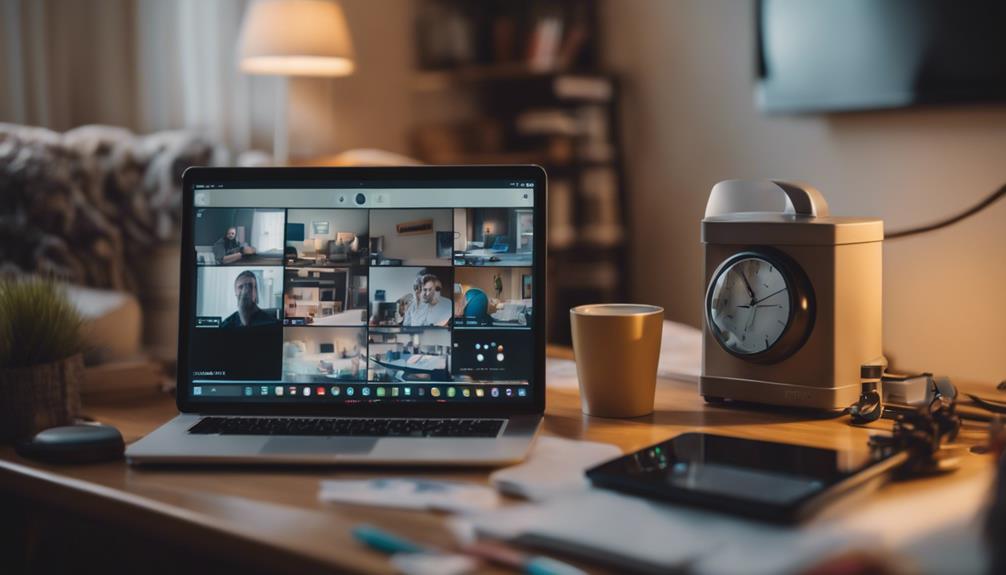When I work remotely with my kids at home, setting boundaries is essential to balance work and family life. I establish clear working hours and stick to them, which helps everyone know when I'm working and when I'm available. Having a dedicated workspace minimizes distractions and signals to my kids that I'm busy. Communicating openly with my kids about my schedule and planning regular breaks for family time keeps everything running smoothly. It also sets a positive example for my children on work ethics and boundaries. Interested in more practical tips and how to implement them effectively?
Key Takeaways
- Establishes clear expectations for both work and family responsibilities.
- Helps maintain focus and productivity during work hours.
- Prevents burnout by ensuring a healthy work-life balance.
- Reduces stress and conflicts between work and family obligations.
- Enhances communication and understanding within the family.
Establish Work Hours
In order to maintain a healthy balance between work and family time, it's crucial to set clear work hours. By establishing these boundaries, I can create a structured routine that allows me to focus better and be more productive.
Setting work hours helps me communicate my availability to family members, so they understand when I'm working and when I'm free. This balance not only improves my work efficiency but also my overall well-being.
Research shows that having set work hours makes it easier to manage my time and tasks effectively. It's about creating a clear division between work and personal life, ensuring I can give my best to both without feeling overwhelmed or exhausted.
Designate Workspaces
Creating a dedicated workspace is vital for maintaining a clear boundary between my professional duties and personal life. By setting boundaries with specific workspaces, I signal to my family—and myself—that I'm in work mode.
Research shows that having a designated area for work boosts focus and productivity, which is essential when juggling remote work and parenting. It helps my kids understand that when I'm in my workspace, I shouldn't be disturbed unless it's urgent.
This separation fosters a more professional environment and mindset, making it easier to switch between roles. Ultimately, these boundaries make sure I can excel in my job while still being present for my family when needed.
Communicate With Kids

Having open and honest conversations with my kids about work boundaries helps them understand and respect my work time. I find that when I communicate with kids clearly, it creates a supportive environment where everyone can thrive.
Setting clear expectations about when I'm available and when I need to focus fosters a harmonious work-from-home atmosphere. By involving them in discussions about my work routines, we build a sense of teamwork and cooperation.
Establishing these communication channels means they know what's expected and feel included in the process. This mutual understanding not only keeps disruptions at bay but also nurtures a balanced relationship between my professional and family life.
It's all about finding that innovative way to blend both worlds seamlessly.
Plan for Breaks
Planning for breaks is essential to juggling work and family life effectively.
I schedule regular downtime to balance work and play, ensuring I can prioritize quality interaction with my kids.
These breaks help me recharge and stay productive throughout the day.
Schedule Regular Downtime
Scheduling regular breaks not only boosts productivity but also helps me stay connected with my kids throughout the workday. By integrating downtime into my schedule, I maintain a healthy work-life balance and a structured work routine. These breaks provide essential mental rest, reducing stress and preventing burnout.
I find that stepping away from my desk to spend quality moments with my kids recharges my energy and focus. It's amazing how a simple, planned pause can make a significant difference in my day. Taking these breaks isn't just about relaxation; it's about establishing a sustainable, efficient workflow that benefits both my professional responsibilities and my family life.
This approach ensures I'm present for both my work and my loved ones.
Balance Work and Play
Balancing work and play hinges on the strategic integration of breaks into my daily routine. By scheduling regular breaks, I can spend quality time with my kids while maintaining productivity. This approach not only prevents burnout but also promotes a positive work-from-home environment.
Here are some ways I integrate breaks effectively:
- Set a timer: I use timers to remind me when it's time to step away from work and engage with my children.
- Outdoor activities: A quick walk or playtime in the yard rejuvenates us both.
- Creative sessions: We spend break time drawing, crafting, or solving puzzles together.
- Mindful moments: We practice deep breathing or simple yoga stretches to reset our minds.
Planning breaks thoughtfully transforms my work-from-home experience.
Prioritize Quality Interaction
I make the most of my work breaks by focusing on quality time with my kids, making sure our moments together are meaningful and enriching.
When you're working from home with kids, it's important to plan breaks strategically. I find that these breaks not only enhance my productivity but also strengthen my bond with my children.
Research shows that regular breaks improve focus and mental well-being, which is vital for maintaining a positive work-life balance. Engaging in simple activities like reading a book or playing a quick game can make a big difference.
Use Technology Wisely

Harnessing the power of technology can make it much easier to set and maintain boundaries while working remotely with kids.
Using the right technology tools helps create clear communication boundaries, ensuring work and family life don't constantly overlap.
For instance, video call features can signal when I'm in a meeting and shouldn't be disturbed.
Setting email auto-replies manages availability and sets expectations for response times.
Headphones and closed doors also act as essential signals that I'm focused and unavailable.
Key Tools for Setting Boundaries:
- Video call features to signal busy times
- Email auto-replies to manage availability
- Headphones and closed doors as 'do not disturb' signals
- Tech-free zones during family time
Coordinate With Partner
Working remotely with kids becomes more manageable when my partner and I coordinate our schedules and responsibilities effectively. As work-from-home parents, we establish a shared understanding of our work and family duties, ensuring a balanced distribution of childcare.
Open communication about our schedules and needs is key; it enhances our support for each other and allows for flexibility. By discussing boundaries and expectations, we create a harmonious environment that benefits both our professional and personal lives.
Teamwork helps us navigate challenges and find innovative solutions, fostering a successful work-life balance. It's about being empathetic and practical, making sure we both feel valued and supported in our journey of working from home.
Set Realistic Goals

Setting realistic goals when balancing remote work and childcare responsibilities is crucial for managing workload effectively. It can prevent feeling overwhelmed and maintain a balance between work and family. By breaking tasks into smaller chunks and prioritizing critical ones, one can stay focused and motivated. Setting specific, measurable, and time-bound goals helps in achieving objectives efficiently. Allowing buffer time for unexpected interruptions is also necessary to handle any challenges effectively.
Here's what works for me:
- Break tasks into smaller, manageable chunks
- Prioritize the most critical tasks first
- Set specific, measurable, and time-bound goals
- Allow for some buffer time to handle unexpected interruptions
Maintain Flexibility
Maintaining flexibility in my work schedule allows me to better accommodate my family's dynamic needs and unexpected changes. By being open to adjusting boundaries and schedules, I can achieve a healthier work-life balance.
Flexible work hours enable me to prioritize family time without compromising my professional commitments. When unforeseen circumstances arise, adapting with flexibility reduces stress and boosts productivity.
Embracing such an innovative approach to work setups creates a supportive environment for both my career and family obligations. This adaptability is essential for managing the demands of remote work with kids, ensuring that neither my work nor my family suffers.
Frequently Asked Questions
Why Are Boundaries Important When Working With Children?
Boundaries are essential for managing distractions and maintaining work-life balance. They help kids respect my work time and responsibilities. This structure enhances productivity and creates a harmonious environment where both work and family time flourish.
How Do You Set Boundaries With Family When Working From Home?
Did you know 77% of remote workers say time management improves with a dedicated workspace? I set clear work hours, establish a workspace setup, and communicate expectations with family to maintain focus and balance.
Why Is It Important to Have Clear and Consistent Boundaries When Working With Children?
Establishing clear and consistent boundaries is essential for preventing burnout and maintaining productivity. It helps create a predictable environment, allowing me to focus on work while ensuring my kids understand when they can engage with me.
Can You Take Care of a Child While Working From Home?
I can take care of a child while working from home by using flexible schedules and creative childcare arrangements. Balancing both roles isn't easy, but with innovation and planning, it's definitely doable and rewarding.
Conclusion
Working remotely with kids can feel like juggling flaming swords, but setting boundaries makes it manageable. By establishing work hours, creating designated spaces, and communicating clearly with your kids, you can keep your sanity intact.
Planning breaks, using technology wisely, coordinating with your partner, setting realistic goals, and maintaining flexibility will help you thrive. Remember, it's all about balance and patience.
You've got this—your home office can be a place of productivity and harmony.






